
Dian Fossey – Biography
The conference is in memory of Dian Fossey on the 82nd anniversary of her birth, to commemorate her immense contribution to our understanding of primates. Text and photos by the courtesy of Dian Fossey Gorilla Fund International: http://gorillafund.org/
Dian Fossey’s early days
Dian Fossey was born in San Francisco, California in 1932. Her parents had divorced when she was young, so Dian grew up with her mother and stepfather. By all accounts, she was an excellent student and was extremely interested in animals from a very young age. At age 6, she began horseback riding lessons and in high school earned a letter on the riding team.

However, when the time came for Dian to enroll in college courses, she chose business classes at Marin Junior College, as her stepfather, a wealthy businessman, had encouraged her to do. She worked while she was in school, and at age 19, on summer break following her first year of college, she went to work on a dude ranch in Montana. At the ranch she fell in love with and developed an attachment to the animals, but was forced to leave early when she contracted chicken pox.
Still, the experience on the ranch convinced Dian to follow her heart. She returned to school as a pre-veterinary student at the University of California. However, she was challenged by some of the chemistry and physics courses, and eventually turned her focus to a degree in occupational therapy at San Jose State College and graduated in 1954.
Following graduation, Dian interned at various hospitals in California, working with tuberculosis patients. After less than a year she moved to Louisville, Kentucky, where she was hired as director of the occupational therapy department at Kosair Crippled Children Hospital. She enjoyed working with the people of Kentucky and lived outside the city limits in a cottage on a farm. The owners of the farm encouraged her to help with seasonal work with the animals, which she did.
Dian enjoyed the experience on the farm, but she dreamed of seeing more of the world and its abundant wildlife. A friend of hers had been to Africa and brought home pictures and stories of her vacation. Once she had seen the photos and heard the stories, Dian decided that she must one day go there herself. She spent many years longing to go to Africa and realized that if her dream were to come true, it would be because she took things into her own hands. Therefore, in 1963, Dian took out a bank loan and began planning her first trip to Africa. She hired a driver by mail and prepared to set off to the land of her dreams.
Dian Fossey tours Africa (1963)
It took Dian Fossey’s entire life savings, in addition to the bank loan, to make her dream a reality. In September 1963, she arrived in Kenya. Her trip included visits to Kenya, Tanzania (then Tanganyika), Congo (then Zaire), and Zimbabwe (then Rhodesia). John Alexander, a British hunter, served as her guide. The route that he had planned for her included Tsavo, Africa’s largest national park; the saline lake of Manyara, famous for attracting giant flocks of flamingos; and the Ngorongoro Crater, well-known for its abundant wildlife.
The final two sites for her visit were Olduvai Gorge in Tanzania — the archaeological site of Louis and Mary Leakey — and Mt. Mikeno in Congo, where in 1959 American zoologist George Schaller had carried out a pioneering study of the mountain gorilla. Both of these visits proved to be of particular significance. Schaller was the first person to conduct a reliable field study of the mountain gorillas, and his efforts paved the way for the research that would become Dian Fossey’s life work.
A turning point: Dian Fossey visits Dr. Louis Leakey
“I believe it was at this time the seed was planted in my head, even if unconsciously, that I would someday return to Africa to study the gorillas of the mountains.” – Gorillas in the Mist
An experience that Dian would later point to as a pivotal moment in her life was her visit with Dr. Louis Leakey at Olduvai Gorge. During the visit, Leakey talked to Dian about Jane Goodall’s work with chimpanzees in Tanzania, which at the time was only in its third year. He also shared with her his belief in the importance of long-term field studies with the great apes.
Leakey gave Dian permission to have a look around some newly excavated sites while she was at Olduvai. Unfortunately, in her excitement she slipped down a steep slope, fell onto a recently excavated dig and broke her ankle. The upcoming climb that would take Dian to the mountain gorillas seemed to be at risk, but she would not be discouraged so easily. By her own account, after her fall she was more resolved than ever to get to the gorillas.
Dian Fossey’s first encounter with gorillas
On Oct. 16, Dian went to the Travellers Rest, a small hotel in Uganda, close to the Virunga mountains and the mountain gorillas. The hotel was owned by Walter Baumgartel, an advocate of gorilla conservation and among the first to see the benefits that tourism could bring to the area.
Baumgartel recommended that she meet with Joan and Alan Root, wildlife photographers from Kenya who were collecting footage of the mountain gorillas for a photographic documentary. The Roots allowed Dian to camp behind their cabin and, after a few days, took her into the forest to search for gorillas. When they did come upon a group of gorillas and Dian was able to observe and photograph them, she developed a firm resolve to come back and study these beautiful creatures, as she later described in Gorillas in the Mist:
“It was their individuality combined with the shyness of their behavior that remained the most captivating impression of this first encounter with the greatest of the great apes. I left Kabara with reluctance but with never a doubt that I would, somehow, return to learn more about the gorillas of the misted mountains.”
Following her visit to the Virungas, Dian remained in Africa a while longer, staying with friends in Rhodesia. Upon arriving home in Kentucky she returned to work at Kosair, resuming her work as an occupational therapist to repay the loan she had taken to pay for her trip to Africa … all the while dreaming of the day she would return.
Dian Fossey sets off to study the mountain gorillas
As Dian Fossey continued her work in Kentucky at Kosair Children’s Hospital, she also found time to have a number of articles and photographs from her Africa trip published locally. These would serve her well in the spring of 1966, when a lecture tour brought Dr. Louis Leakey to Louisville. Dian joined the crowd and waited in line to speak with Leakey. When her turn came, she showed him some of the articles she had published.
The articles got his attention and during the conversation that followed, Leakey spoke to Dian about heading a long-term field project to study the gorillas in Africa. It ended with Leakey informing Dian that if she were to follow through she would first have to have her appendix removed. Perhaps it was a sign of her strong will that she proceeded to do exactly that, only to hear from Leakey later that his suggestion was mainly his way of gauging her determination!
It was eight months before Leakey was able to secure the funding for the study. Dian used that time to finish paying off her initial trip to Africa and to study. She focused on a Teach Yourself Swahili grammar book and George Schaller’s books about his own field studies with the mountain gorillas. Saying goodbye to family, friends, and her beloved dogs proved difficult.
“There was no way that I could explain to dogs, friends, or parents my compelling need to return to Africa to launch a long-term study of the gorillas. Some may call it destiny and others may call it dismaying. I call the sudden turn of events in my life fortuitous.” – Gorillas in the Mist
In December 1966, Dian was again on her way to Africa. She arrived in Nairobi, and with the help of Joan Root, whom she had met in 1963, acquired the necessary provisions and set off for the Congo in an old canvas-topped Land Rover that Dr. Leakey had purchased for her and which she named “Lily.” On the way, however, Dian made a stop to visit the Gombe Stream Research Centre to meet Jane Goodall and observe her research methods with chimpanzees.
Kabara: Beginnings (1966/1967)
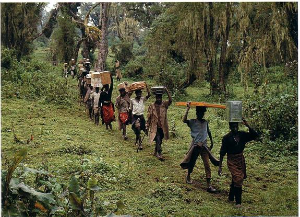
Alan Root accompanied Dian Fossey from Kenya to the Congo and was instrumental in helping her obtain the permits she needed to work in the Virungas. He helped her recruit two African men who would stay and work with her at camp, as well as porters to carry her belongings and gear to the Kabara meadow. Root also helped her to set up camp and gave her a brief introduction to gorilla tracking. It was only when he left after two days at Kabara that Dian realized just how alone she was. Soon, however, tracking the mountain gorillas would become her single focus, to the exclusion even of simple camp chores.
On her first day of trekking, after only a 10-minute walk, Dian was rewarded with the sight of a lone male gorilla sunning himself. The startled gorilla retreated into the vegetation as she approached, but Dian was encouraged by the encounter. Shortly thereafter, Sanwekwe, an experienced gorilla tracker who had worked with Joan and Alan Root in 1963, joined Dian, and the prospects for more sightings improved.
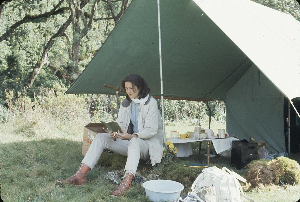
Slowly, Dian settled into life at Kabara. Space was limited. Her 7-by 10-foot tent served as bedroom, bath, office and clothes-drying area (an effort that often seemed futile in the wet climate of the rainforest). Meals were prepared in a run-down wooden building and rarely included local fruits and vegetables, other than potatoes. Dian’s mainstay was tinned food and potatoes cooked in every way imaginable. Once a month, she would hike down the mountain to “Lily” and make the two-hour drive to the village of Kikumba to restock the pantry.
Sanwekwe proved invaluable as a tracker and taught Dian much of what she came to know of tracking. With his help and considerable patience, she eventually identified three gorilla groups in her area of study along the slopes of Mt. Mikeno.
Dian Fossey learns to habituate the gorillas
“The Kabara groups taught me much regarding gorilla behavior. From them I learned to accept the animals on their own terms and never to push them beyond the varying levels of tolerance they were willing to give. Any observer is an intruder in the domain of a wild animal and must remember that the rights of that animal supersede human interests.” – Gorillas in the Mist
Initially, the gorillas would flee into the vegetation as soon as she approached. Observing them openly and from a distance, over time, Dian Fossey was eventually able to gain their acceptance. She put the gorillas at ease by imitating regular activities like scratching and feeding as well as copying their contentment vocalizations. Through her observations, she was also able to begin identifying the individuals that made up each group. Like George Schaller before her, Dian relied heavily on the gorillas’ individual “noseprints” for purposes of identification. She sketched the gorillas and their noseprints from a distance and slowly came to recognize individuals within the three distinct groups in her study area, learning much from their behavior and keeping detailed records of daily encounters.
Escape from Zaire
Dian Fossey worked tirelessly, every day carrying a pack weighing nearly 20 pounds (some days nearly double that) until the day she was driven from camp by the worsening political situation in the Congo. On July 9, 1967, she and Sanwekwe returned to camp to find armed soldiers waiting. There was a rebellion in the Kivu Province of Zaire and the soldiers had come to “escort” her down the mountain to safety.
She spent two weeks in Rumangabo under military guard until, on July 26, she was able to orchestrate her escape. She offered the guards cash if they would simply take her to Kisoro, Uganda, to register “Lily” properly and then bring her back. The guards could not resist and agreed to provide an escort. Once in Kisoro, Dian went straight to the Travellers Rest Hotel, where Walter Baumgärtel immediately called the Ugandan military. The soldiers from Zaire were arrested, and Dian was safe.
In Kisoro, Dian was interrogated and warned not to return to Zaire. After more questioning in Kigali, the capital of Rwanda, she finally flew to back to Nairobi where she met with Dr. Leakey for the first time in seven months. There they decided, against the advice of the U.S. Embassy, that Dian would continue her work on the Rwandan side of the Virungas.
Dian Fossey founds Karisoke™ (1967)
“More than a decade later as I now sit writing these words at camp, the same stretch of alpine meadow is visible from my desk window. The sense of exhilaration I felt when viewing the heartland of the Virungas for the first time from those distant heights is as vivid now as though it had occurred only a short time ago. I have made my home among the mountain gorillas.” – Gorillas in the Mist
Much of Dian Fossey’s success in the study of the mountain gorilla came about with the help of people she met along the way. This would prove true once again as she moved her focus to Volcanoes National Park on the Rwandan side of the Virungas. In Rwanda, Dian had met a woman named Rosamond Carr, who had lived in Rwanda for some years and was familiar with the country.
Carr introduced Dian to a Belgian woman, Alyette DeMunck, who had been born in the Kivu Province of Zaire and lived in the Congo from an early age, remaining there with her husband until the political situation forced them to move to Rwanda. Alyette and Dian became fast friends, and Alyette became one of Dian’s staunchest supporters in the years to come.
Alyette DeMunck knew a great deal about Rwanda, its people and their ways, and she offered to help Dian search for an appropriate site for her new camp and renewed study of the mountain gorillas of the Virungas. At first, Dian was disappointed to find the slopes of Mt. Karisimbi crowded with herds of cattle and frequent signs of poachers. However, the search was rewarded after nearly two weeks, when Dian reached the alpine meadow of Karisimbi, where she had a view of the entire Virunga chain of extinct volcanoes.
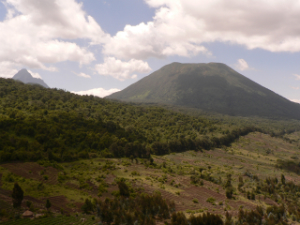
So it was that on Sept. 24, 1967, Dian Fossey established the Karisoke™ Research Center: “Kari” for the first four letters of Mt. Karisimbi that overlooked her camp from the south and “soke” for the last four letters of Mt. Visoke, the slopes of which rose to the north, directly behind camp.
“Little did I know then that by setting up two small tents in the wilderness of the Virungas I had launched the beginnings of what was to become an internationally renowned research station eventually to be utilized by students and scientists from many countries.” – Gorillas in the Mist
Dian Fossey’s work at Karisoke™ gets underway
Dian faced a number of challenges upon setting up camp at Karisoke. For one, upon the departure of her friend Alyette, she was left with no interpreter. Dian spoke Swahili and the Rwandan men she had hired spoke only Kinyarwanda. Slowly, and with the aid of hand gestures and facial expressions, they learned to communicate. A second and very significant challenge was that of gaining “acceptance” among the gorillas in the area so that meaningful research could be done in close proximity to them. This would require that the gorillas overcome their shy nature and natural fear of humans.
George Schaller’s earlier work served as a basis for the techniques Dian would use to habituate the gorillas to her presence. Schaller had laid out suggestions in his book The Mountain Gorilla, which Fossey used to guide herself through the process of successfully habituating six groups of gorillas in the Kabara region.
At Karisoke, Dian continued to rely on Schaller’s work and the guidelines he set forth. She also came to depend on the gorillas’ natural curiosity in the habituation process. While walking or standing upright increased their apprehension, she was able to get quite close when she “knuckle-walked.” She would also chew on celery when she was near the groups, to draw them even closer to her. Through this process, she partially habituated four groups in 1968.
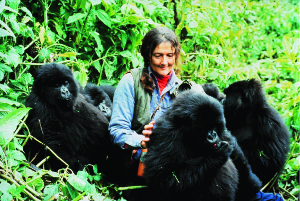
It was also in 1968 that the National Geographic Society sent photographer Bob Campbell to photograph her work. Initially, Dian saw his presence as an intrusion, but they would eventually become close friends. His photographs of Fossey among the mountain gorillas launched her into instant celebrity, forever changing the image of the gorillas from dangerous beasts to gentle beings and drawing attention to their plight.
Gaining scientific credentials
Dian Fossey had never felt entirely up to the scientific aspects of studying the mountain gorillas because she did not have, in her view, adequate academic qualifications. In order to rectify this, in 1970 she enrolled in the department of animal behavior at Darwin College, Cambridge, under Dr. Robert Hinde, who had also been Jane Goodall’s supervisor. She traveled between Cambridge and Africa until 1974, when she completed her Ph.D. Armed with the degree, she now felt that she could be taken more seriously. This also enhanced her ability to continue her work, command respect, and most importantly, secure more funding.
Protecting the gorillas
Even as Dian celebrated her daily achievements in collecting data and gaining acceptance among both the mountain gorillas and the world at large, she became increasingly aware of the threats the gorillas faced from poachers and cattle herders. While gorillas were not usually the targets, they became ensnared in traps intended for other animals, particularly antelope or buffalo.
Dian fought both poachers and encroachment by herds of cattle through unorthodox methods, wearing masks to scare poachers, burning snares, spray-painting cattle to discourage herders from bringing them into the park, and, on occasion, taking on poachers directly, forcing confrontation. She referred to her tactics as “active conservation,” convinced that without immediate and decisive action, other long-term conservation goals would be useless as there would eventually be nothing left to save.
These tactics were not popular among locals who were struggling to get by. Additionally, the park guards were not equipped to enforce the laws protecting the forest and its inhabitants. As a last resort, Dian used her own funds to help purchase boots, uniforms, and food and provide additional wages to encourage park wardens to be more active in enforcing anti-poaching laws. These efforts spawned the first Karisoke anti-poaching patrols, whose job it was to protect the gorillas in the research area.
Dian Fossey and Digit
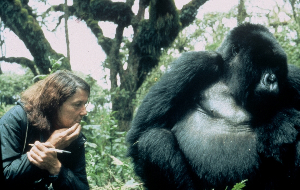
In the course of her years of research, Dian established herself as a true friend of the mountain gorilla. However, there was one gorilla with whom she formed a particularly close bond. Named Digit, he was roughly 5 years old and living in Group 4 when she encountered him in 1967. He had a damaged finger on his right hand (hence, the name) and no playmates his age in his group. He was drawn to her and she to him. Over time, a true friendship would form.
Tragically, on Dec. 31, 1977, Digit was killed by poachers. He died helping to defend his group, allowing them to escape safely. He had been stabbed multiple times and his head and hands were severed. Eventually, there would be more deaths, including the dominant silverback Uncle Bert, and Group 4 would disband. It was then that Dian Fossey declared war on the poachers.
Digit had been part of a famous photo shoot with Bob Campbell and, as a result, had served as the official representative of the park’s mountain gorillas, appearing on posters in travel bureaus throughout the world. After much internal debate, Dian used his celebrity and his tragic death to gain attention and support for gorilla conservation. She established the Digit Fund to raise money for her “active conservation” and anti-poaching initiatives. The Digit Fund would later be renamed the Dian Fossey Gorilla Fund International (Fossey Fund).
In 1980, Dian moved to Ithaca, New York, as a visiting associate professor at Cornell University. She used the time away from Karisoke™ to focus on the manuscript for her book, Gorillas in the Mist. Published in 1983, the book is an account of her years in the rainforest with the mountain gorillas. Most importantly, it underscores the need for concerted conservation efforts. The book was well received and, like the movie of the same name, remains popular to this day.
Dian Fossey’s death (1985)
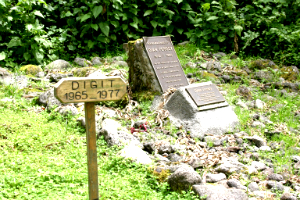
Dian had not been back in Rwanda long when, a few weeks before her 54th birthday, she was murdered. Her body was found in her cabin on the morning of Dec. 27, 1985. She had been hit twice on the head and face with a machete. There was evidence of forced entry but no signs that robbery had been the motive.
Theories about Dian Fossey’s murder were many and varied but never fully resolved. She was laid to rest in the graveyard behind her cabin at Karisoke™, among her gorilla friends and next to her beloved Digit.
“When you realize the value of all life, you dwell less on what is past and concentrate on the preservation of the future.” – Gorillas in the Mist
Text and photo copyright: © 2014 Dian Fossey Gorilla Fund International, Inc.